IT Assets Structure
9 minute read
Click the Manage IT Assets button to open the IT Asset structure. Use this tab to create the structure of your IT assets. User-defined Structures are prefixed with a lowercase x.
Categories
Click the New button and select Category to create a new category. You can enter a name and labels in English and German for the category. You can also enter a description in both languages. Below any category, you can create IT assets or subcategories.
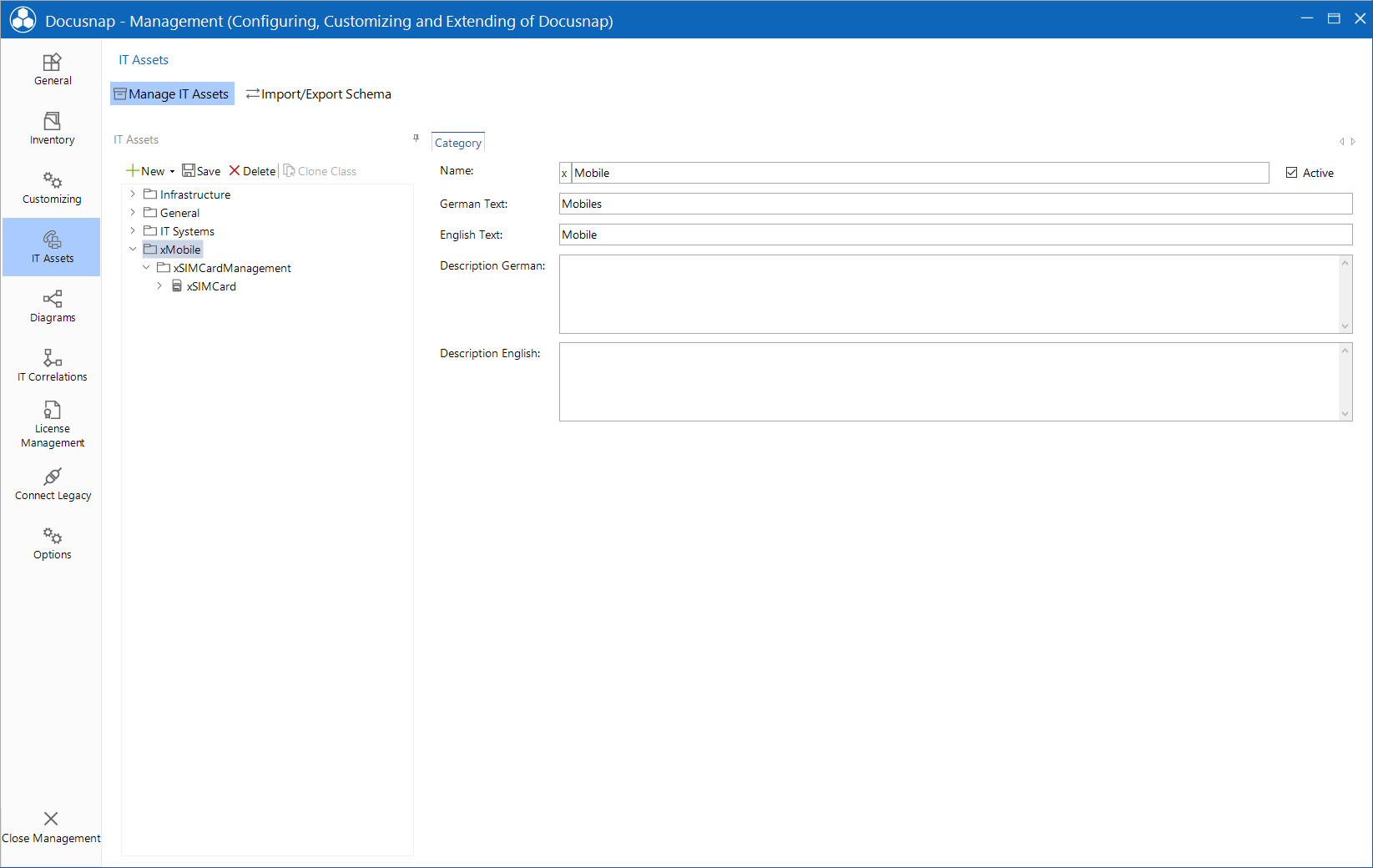
Class
Click New button and then Class to create an IT asset under the selected category node. You can enter a name and labels in English and German for the IT asset. Docusnap suggests a particular icon for each class. You can change this icon using the  button. The icon selected in Icon is used to display the IT assets in the tree. The icon selected in preview icon is used when IT assets are displayed in maps or diagrams. If necessary the size of the icons is adjusted. To be displayed correctly, the original size of the icons should be about 16x16 pixels and the size of the preview icons should be about 100x100 pixels.
button. The icon selected in Icon is used to display the IT assets in the tree. The icon selected in preview icon is used when IT assets are displayed in maps or diagrams. If necessary the size of the icons is adjusted. To be displayed correctly, the original size of the icons should be about 16x16 pixels and the size of the preview icons should be about 100x100 pixels.
By unchecking the Active checkbox, you can deactivate the class so that it is no longer selectable when you create new IT assets. In the display field, select the property whose value should be displayed in the tree view. After you have saved the class, Docusnap creates the General tab and the General section. Subclasses may be created under each class.
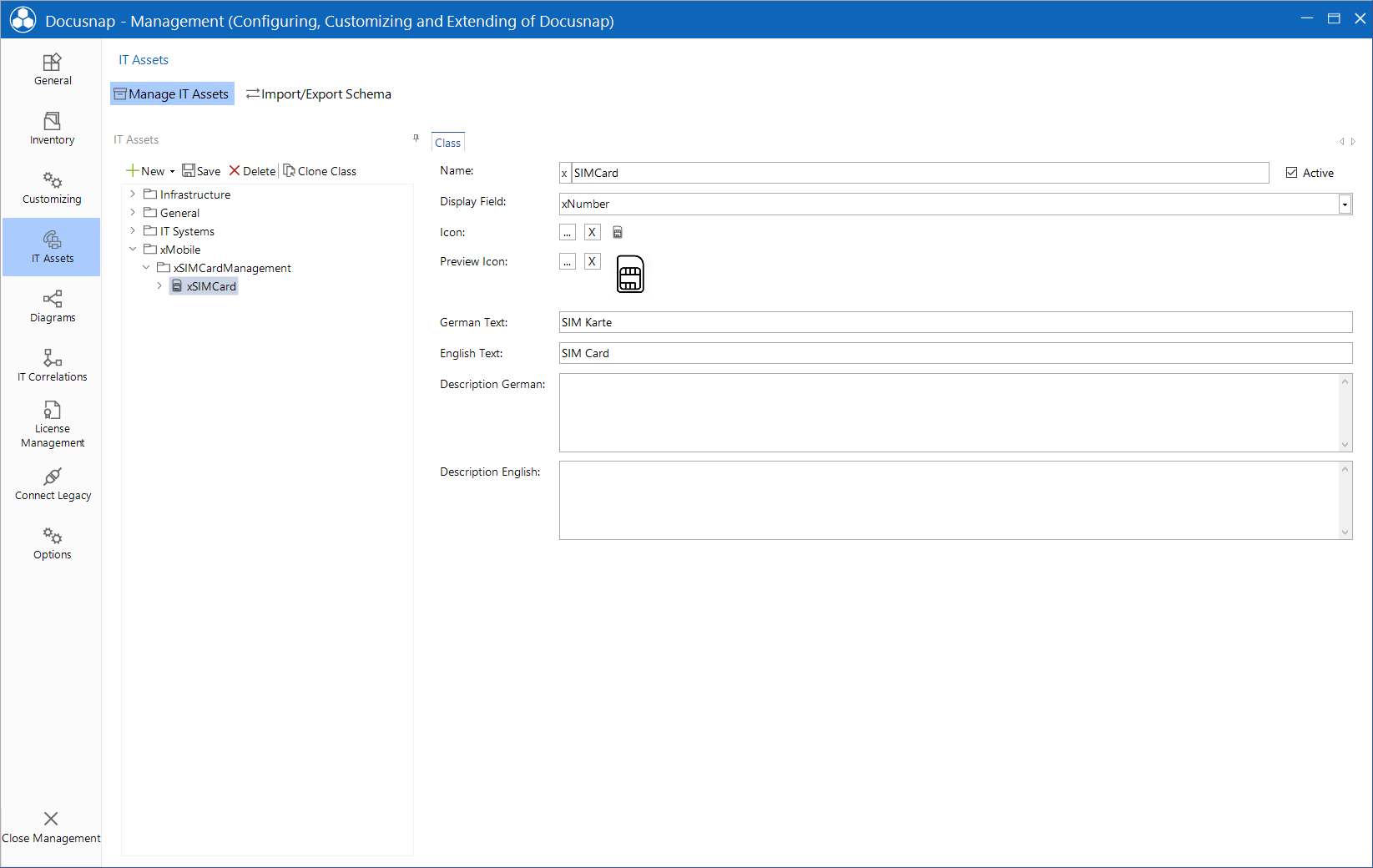
Tab
In addition to the General tab, which is created for each class and which cannot be deleted, you may create other tabs. These will be displayed as additional tabs when you create IT assets. Besides the name, you can enter labels in English and German for each tab. The Active checkbox allows you to enable/disable the tab.
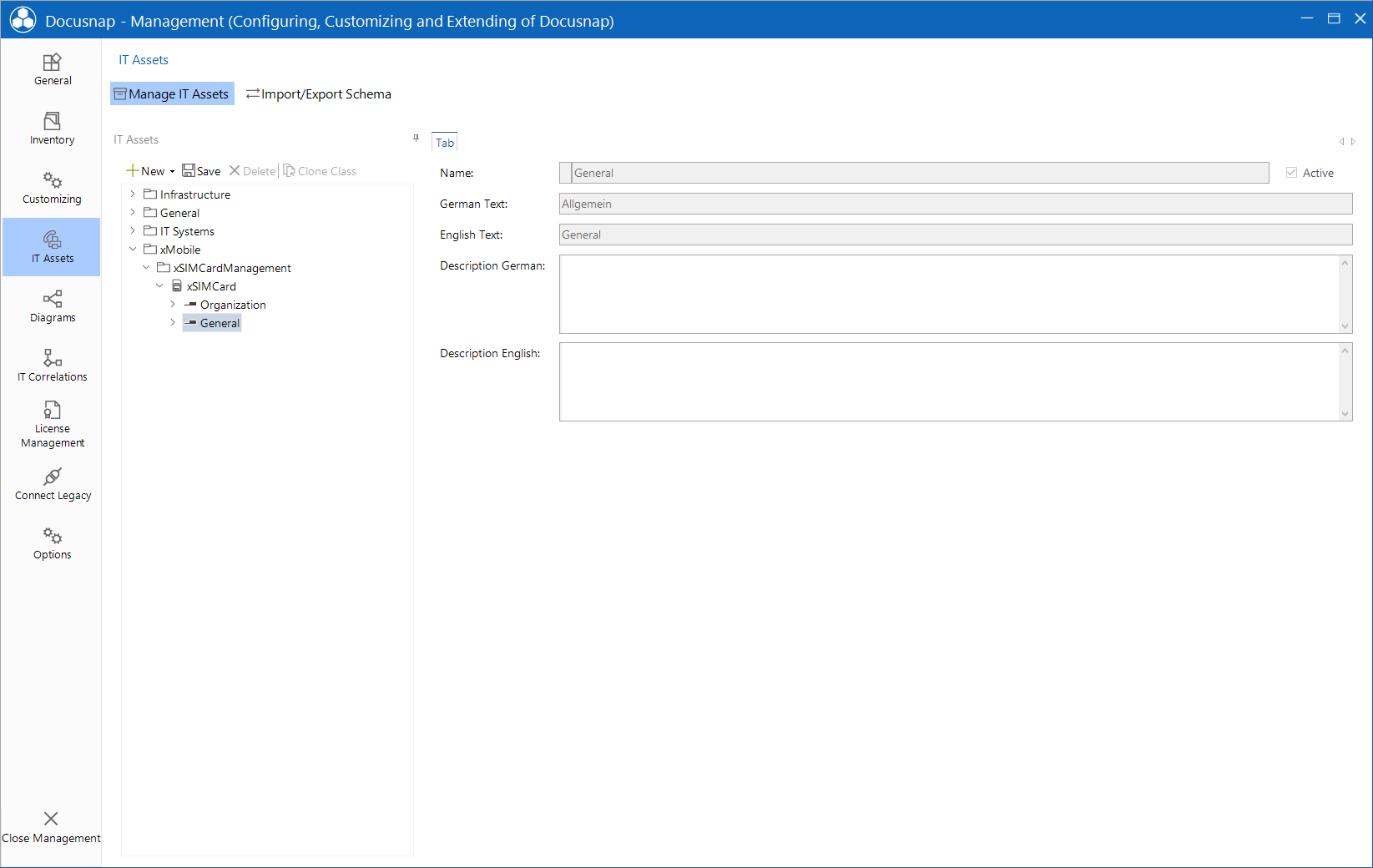
Section
For each class, Docusnap creates a General section. You can rename or delete this section. Sections are used to group the properties of the IT assets in the editor area. You can enter a name and labels in English and German for each section. The Active checkbox allows you to enable/disable the section. The Column Formats allow you to define how to arrange the properties in the editor area.
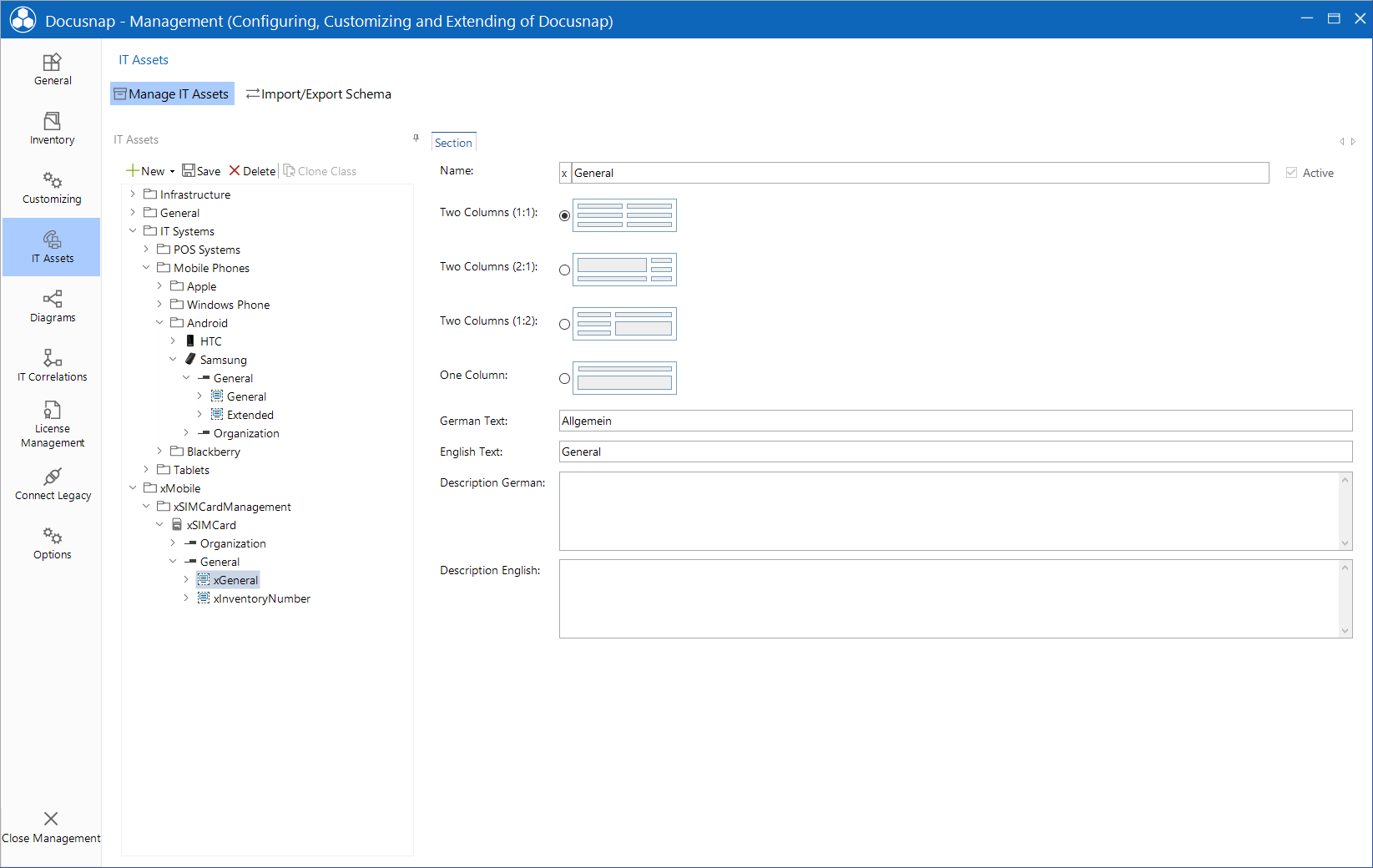
Properties
Properties are used to specify values for the IT assets. Create the properties under the desired section. Click the New button and select Property to define new properties. You can enter a name and labels in English and German for each property. The Active checkbox allows you to enable/disable the property. Various property types are available:
- Color Picker: With the color picker type a color can be selected.
- Data Grid: With the Data Grid multiple entries can be assigned to one IT asset. For example, to one IT asset can be assigned to multiple processes. The mapping is stored in an additional table. These tables can be created in the Manage Tables tab.
Reference Table: Name of the table to be displayed in the data grid. This table contains the list of the available items.
Mapping Table: Name of the table in which the connection between the assigned values and the IT assets is stored.
Reference Field: Name of the field in the related table where the selected data from the reference table will be stored.
Foreign Key Field: Name of the column in which the ObjectID of IT assets will be stored. Sort Entries: This option sorts the entries alphabetically according to the first column. If this option is not active, views will use the sorting specified in the statement, and tables will display the data in the order in which it was inserted into the table. - Date: If you select the Date type, a date selection for specifying the date will be provided in the editor area.
- Decimal: If you select the Decimal type, only decimal numbers can be inserted into the text box. In addition, you can set a factor for the conversion of numeric values. Example: A factor of 1024 would convert a value from bytes into kilobytes. Here, you can define the formatting of numeric values according to standard conventions. Valid placeholders are the # character for any numeric value and the digit 0 for numeric values which are padded with leading zeros if they are too small. The comma is used as the thousands separator, and the period as the decimal separator. The specified unit is added to the property name in brackets in the header. Examples: #,##0.00 MB, 00 h
- List: If you select the List type values will be selectable in the editor area. Only one value can be selected. For the selection list, different view formats are available, which are defined in the List Type combobox.
Sort Entries: This option sorts the entries alphabetically according to the first column. If this option is not active, views will use the sorting specified in the statement, and tables will display the data in the order in which it was inserted into the table.
- Combobox: As data sources you can use a database table or initial values. A reference to a table is specified [TableName] and a reference to an initial value is input with {InitialValue}.
- Selection Grid: If a list has a lot of entries or if for selection data from several columns are relevant, a Selection Grid can be used. In the Selection Grid you can specify as many columns as you want and it is possible to filter the list. The data source is specified in the list reference. If a view is used as a database table, the statement can also be used to specify a sort order of the data with “order by” and to filter it, for example, according to the company by using the variable {AccountID} as a filter.
- Selection TreeView: The Selection TreeView is used when the data should be displayed in hierarchical form. The specified parameters are the same as for the Selection Grid, only that in addition a recursion field can be specified for the TreeView. For example, domains may have a subdomain, or sites may be created beneath other sites. To display this structure, the selection tree view is used. The Selection TreeView shows the Display Field of the selected table or view.
- List Values: If List Values is selected the additional tab List Values is displayed. Here entries can be defined, which are then available in a combo box for selection in the editor area. The manual entries are always sorted alphabetically.
- Multi-Line Text: If you select the Multi-Line Text type, you can enter text without any length limitation. For this type, you can specify the height of the text box in the Line Height field.
- Network Information: If you select the Network Information type, you can specify the IP Address, the Subnet Mask, and the MAC Address for this IT asset. This information can then also be added to the network maps.
- Number: If you select the Number type, the text box will only accept integers.
In addition, you can set a factor for the conversion of numeric values.
Here, you can define the formatting of numeric values according to standard conventions and include a unit. Valid placeholders include the hash symbol “#” for any numeric value and “0” for numeric values that should be padded with leading zeroes if they are too small for the field. The thousands separator is a comma, and the period is used as the decimal separator. The specified unit is added to the property name in brackets in the header. Examples: #,##0.00 MB or 00 h - Number Server: The number server can be defined in the Advanced ribbon and can be used to assign a continuous number to every new generated IT asset. In the Settings an existing Number Server can be chosen, when you select the type Number Server. You find further information on the definition of Number Servers in the configuration manual.
- Text: If you select the Text type, Docusnap will display a text box in the editor area.
- Tree View: With the Tree View multiple entries can be assigned to one IT asset. The selection can also be represented as a hierarchical tree. The mapping is stored in an additional table. These tables can be created in the Manage Tables tab.
Reference Table: Name of the table to be displayed in the data grid. This table contains the list of the available items.
Mapping Table: Name of the table in which the connection between the assigned values and the IT assets is stored.
Reference Field: Name of the field in the related table where the selected data from the reference table will be stored.
Recursion Field: Name of an existing recursive field if the reference table is recursive.
Foreign Key Field: Name of the column in which the ObjectID of IT assets will be stored. - User/Group Selection: With the type User/Group Selection users or groups from the ADS inventory can be assigned to an IT asset. When creating the IT asset the name of wanted user or group can be entered. Once the first letter is typed, the matching entries are suggested. Users and groups can be added via enter key or selection via the mouse from the suggestion list. Click the
 button to open the dialog for the advanced search. In this dialog the selection of users and groups can be filtered by several conditions. Afterwards the selected user or group can be assigned to the IT asset. You find further information on the filter in the chapter Permission Analysis of the user manual.
button to open the dialog for the advanced search. In this dialog the selection of users and groups can be filtered by several conditions. Afterwards the selected user or group can be assigned to the IT asset. You find further information on the filter in the chapter Permission Analysis of the user manual. - Yes/No: For a property of the *Yes/No type, a checkbox will be displayed in the editor area.
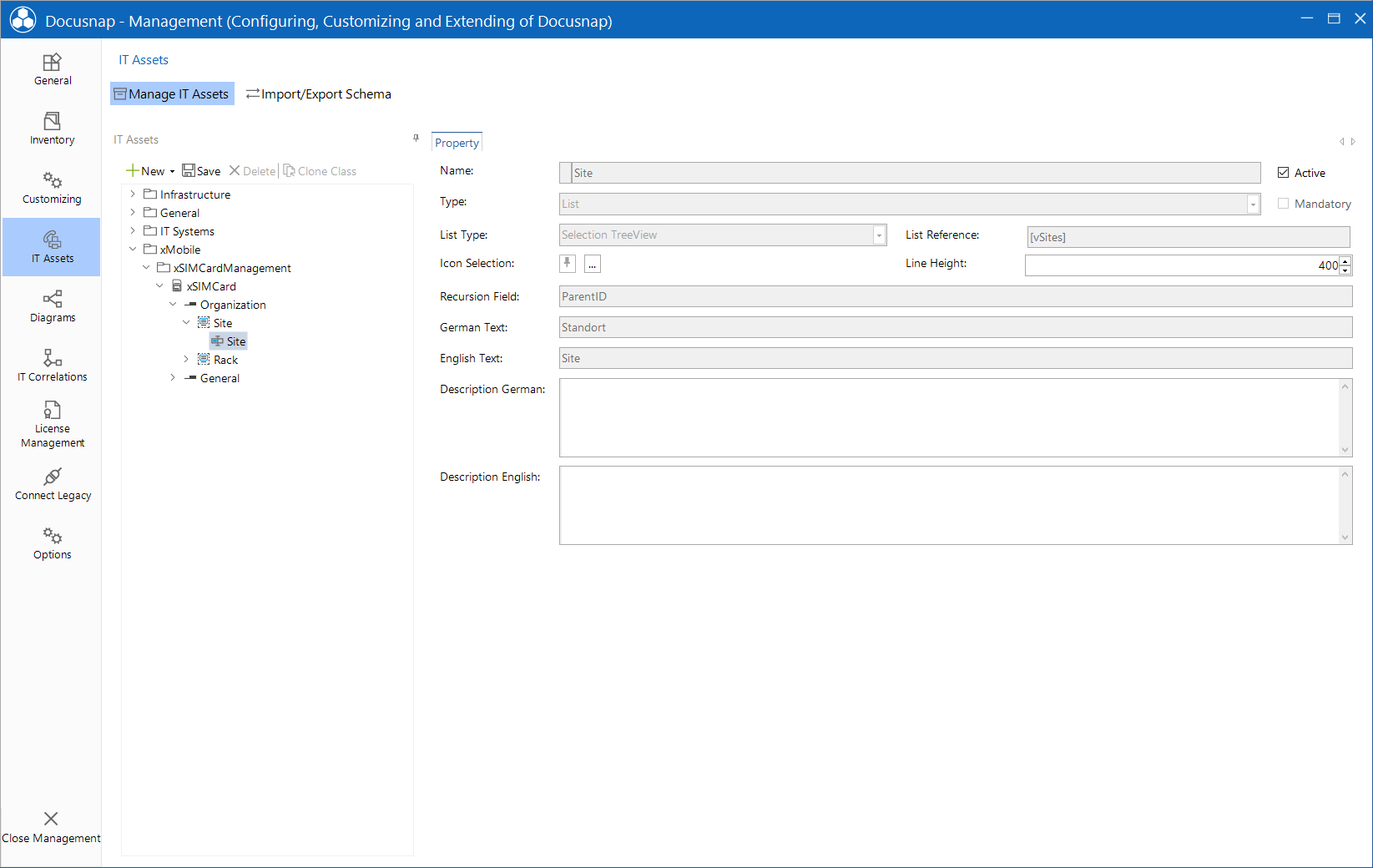
Icons
For the Data Grid, the Selection TreeView, the Selection Grid and the Tree View, an icon can be selected, which is then displayed with this property. If desired, you can define your own icons for different types. For example, for each system type (workstation, server, etc.) the appropriate icon.
![]()
You can move classes and categories or change the order in which the properties are listed in the editor area by drag&drop.